Nina Karnikowski crosses off a bucket list item by going shopping inside the famous souks of Marrakesh, Morocco.
"You know the other name for Marrakesh, don't you? 'More cash', because you always need more money for shopping here!"
It's a fitting line delivered bang on time by my guide, Abdellah Amghar, from Australia-based Moroccan tour company By Prior Arrangement, as we enter the narrow, chaotic streets of the Marrakesh souk district inside the medina quarter. Amghar, I soon discover, speaks almost exclusively in these sorts of one-liners, and looks cool, calm and collected in his white floaty djellaba as we forge further into the souks. I, on the other hand, am already hot, slightly overwhelmed and wondering how on earth I would have navigated this tangled knot of laneways without a guide.
"This is an amazing maze of alleyways!" Amghar shouts over his shoulder as he forges ahead past stalls heaped with handmade silver jewellery, thick patterned woollen carpets and vibrant babouche slippers. Marrakesh is known as Morocco's city of artisans, with 60 per cent of the working population occupied as an artisan of some sort, a figure I begin to comprehend as we whiz past these treasures. "The deeper you go the better, because you're buying from the makers, not the middle men," Amghar says.
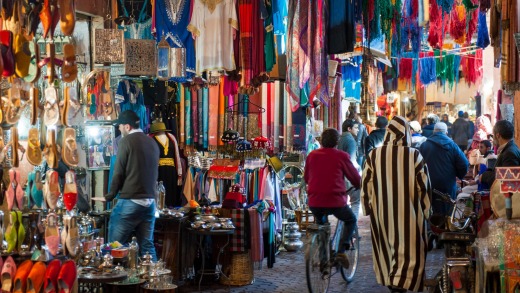
Before long we reach the dyers' quarter, where sheaves of richly-dyed wool in fuchsia-pink, grass green and saffron yellow hang from the walls and ceilings. A worker to my right hurries by with a wheelbarrow piled high with cobalt blue wool, while to my left a steaming dye vat bubbles away with a mass of poppy red wool sitting beside it. "The women who make Berber carpets get their wool from here," says Amghar over his shoulder as we head out through a series of ever narrower alleyways lined with hundreds of filigree metal lanterns. "Abdellah!", I yell out as I puff along behind him, "where are we going?"
"To the blacksmiths area, to see the men who make lamps, lanterns, bells, doors..."
We turn a corner and the end of his sentence is swallowed by the intense clanging and banging of the blacksmiths. They sit on the ground around open fires, soldering and hammering away. We just have time for a quick visit to an artisan named Hassan, who looks to be in his mid-40s and has been making beautiful handmade padlocks here since he was nine years old. Then we're off again into the leather souk, where the stalls are laden with handmade shoes, belts and handbags crafted from leather in a rainbow of colours. Turning another corner, we find ourselves in the midst of a leather auction. Hundreds of beige-coloured skins are piled high all around us, and local djellaba-clad men wave money in each other's face, brokering deals to buy the skins in bulk which they'll then transform into pouffes, bags, shoes and more to sell. It's utterly chaotic, and utterly wonderful.
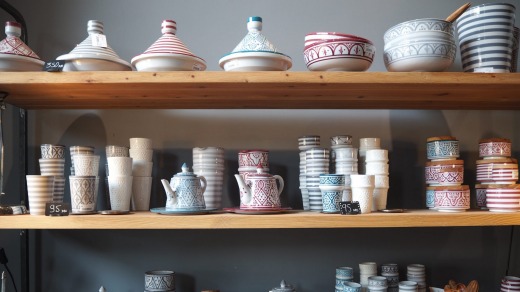
Our race around the souks finishes at the oldest and biggest herboriste (herbalist) in Marrakesh, the entrance of which is lined with metre-high woven baskets overflowing with medicinal herbs and spices. Inside, in a room where the walls are lined from top to bottom with glass jars, packets of amber and essential oils, we meet a witch doctor dressed in a white lab coat. "These are different animal parts, like snakeskin, bat, fox skin, iguana," he says, pointing to various jars. "Normally when we have some jinn [spirit] in the house, we take a little bit from about five or six products and put them in a talisman to keep in the house. There are different ingredients for each different jinn – sometimes you put myrrh, sometimes you put serpent, it's always different," he says, shrugging his shoulders.
I'm still digesting this jinn scenario as we sit – or rather flop – down for lunch 10 minutes later at a chic restaurant called Le Jardin. This palm and banana tree-filled courtyard space is a true oasis, and the perfect spot for taking refuge from the brilliant madness of the souks. We pull up a chair under a bamboo grove and order fresh orange juice and tasty lamb tagines as we watch a small tortoise inch its way across the iridescent green floor tiles. I'm red-faced and sweaty, while Amghar is still perfectly composed. His white djellaba also remains wrinkle-free, and when I can't help but comment on it, Amghar simply smiles and nods his head slowly. "We Moroccans know how to chillax, how to live in the present. That's why we're the happiest people in the world." Looking at him in that moment, I can almost believe it, too.
www.visitmorocco.com
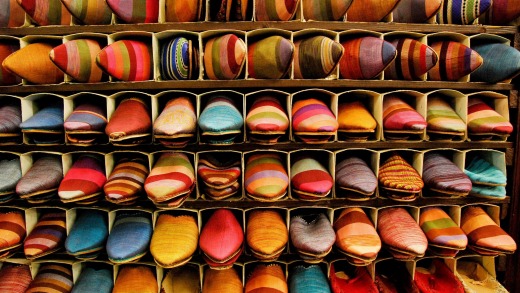
Emirates flies from Sydney and Melbourne to Casablanca via Dubai from about $1680 return, see emirates.com/au. From Casablanca, connect to Marrakesh on a 55-minute Royal Air Maroc flight; see www.royalairmaroc.com.
Riad Adore is a chic, contemporary 10-room riad in a central area of the medina, close to the souks and monuments and the Jemaa el-Fnaa main square. Room rates start at about $200 a night in the low season including breakfast, with a three-night minimum stay. See www.riadadore.com.
By Prior Arrangement creates small bespoke luxury tours and private itineraries to Morocco based around shopping, art, architecture, gardens, food or trekking; see www.bypriorarrangement.com.
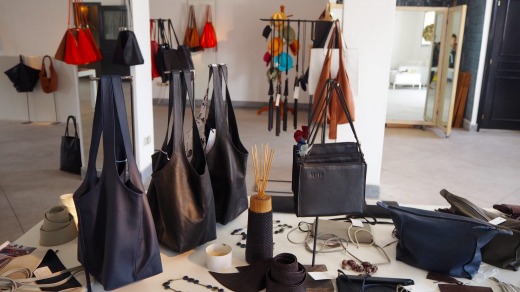
There's an undeniable romance about exploring the winding alleyways of the souks, but if you're looking for a place where you can breathe, focus, and simply be left alone, head away from the medina to these contemporary boutiques in Marrakesh's up-and-coming areas.
Patrizia Bell-Banner, Marrakesh-based interior designer and By Prior Arrangement's high-end shopping guide, can escort you through Marrakesh's more modern shops, starting with 33 Rue Majorelle, opposite the city's famous Majorelle gardens. "This whole area has been pulled up since the gardens were renovated by Yves Saint Laurent in the '80s," says Bell-Banner. This two-level concept store is filled with goodies from some of Morocco's top contemporary designers, including sustainable homewares like rice sieves refashioned into mirrors and flour bags that are now stylish placemats, as well as chic fashion, jewellery and accessories including clutches made from colourful tribal rugs, raffia brogues, colourful wool baskets and more. See www.bypriorarrangement.com.
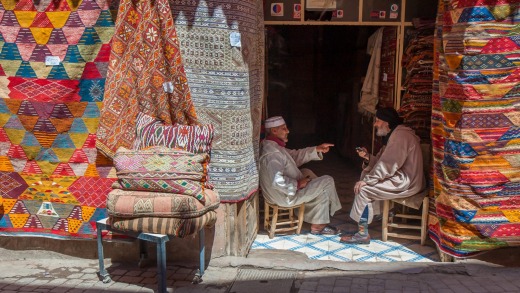
Anitan (Rue Yves Saint Laurent Majorelle) is a chic, airy space offering a well-curated selection of top quality antique Moroccan and central Asian carpets and textiles that have been cleaned and patched up for you, and can be shipped anywhere in the world. For those who value quality over quantity, and can't quite stomach the exhausting haggling required to purchase textiles in the souks. See www.anitanrugs.com.
Belgian designer Martine Hillen makes luxurious soft-as-butter bags, clutches, belts and wallets from untreated, naturally-dyed Moroccan leather at her spacious warehouse-style shop M'H in Sidi Ghanem, the industrial zone of Marrakesh outside the medina. This area began thriving as a shopping district a decade ago when Marrakesh started expanding. "The French were looking for areas outside of the medina where they could work more freely, space-wise," Bell-Banner says. The area is now filled with designer showrooms and warehouses, and is the place to head for high-end goods that are made in Morocco but that, as Bell-Banner says, "aren't too flowery, and will work everywhere." See www.martinehillen.com.
Many of Marrakesh's high-end hotels and riads – including the uber-luxurious La Mamounia and Relais & Chateaux – buy their embroidered linens from the small Chez Zoe factory in Sidi Ghanem. "This is Marrakesh's best-kept secret; what I'd do to get my hands on their mailing list!", laughs Bell-Banner. In this small space you'll see white-clad workers quietly hand-stitching the edges of stunning hooded towelling robes, towels and sheets. You can buy direct and get names stitched into any of your purchases. They ship worldwide. See www.chezzoe.com.